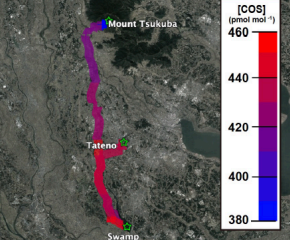SUMMARY
Aeris Technologies discusses with Gas Pathways its high-fidelity, laser-based gas sensing solution, used to detect and quantify methane and ethane emissions at oil and gas facilities down to the part-per-billion.
Q: Briefly can you explain how Aeris Technologies can help oil and gas companies in their decarbonisation journey?
A: As a part of Project Canary, Aeris Technologies’ goal is to help companies identify, measure, understand, and act to reduce various GHG emissions across the energy value chain. Our high-fidelity, laser-based gas sensing solution detects and quantifies methane and ethane for oil and gas facilities down to the part-per-billion. Created in the lab and used by hundreds of leading academic and research institutions across the globe, the Aeris MIRA platform combines the latest advancements in photonics and electronics with our patented compact gas cell. We have adapted the technology to bring this laboratory-grade gas analysis to the field with a line of portable and fixed lower-cost trace gas analyzers. Oil and gas companies can now rely on this lab-grade technology to measure their emissions precisely using solar-powered continuous fixed fence-line monitors and/or mobile gas analysers mounted on vehicles and drones. These high-fidelity gas measurements feed sophisticated cloud-based software and data analytics, including real-time smart alerting as well as cutting-edge physics-based leak quantification algorithms that calculate facility-level methane emissions with the highest accuracy.
Together, Project Canary and Aeris Technologies are helping companies address complex emissions problems by delivering confidence in results.
Q: There’s a wide range of technologies and equipment being used to monitor methane leaks, including LiDAR sensors and even airplanes. What are the advantages drones provide for monitoring methane leaks?
A: Drone emission monitoring (DEM) offers high spatial resolution, allowing for safe, up-close inspection for more precise source localisation. DEM can also quantify total site emissions by concentrically flying around assets to determine emissions flux using a mass/balance approach. The mobility of drones makes them uniquely suited to monitor assets with high levels of spatial resolution.
Q: Granularity and accuracy of data is becoming more and more important for mitigating methane leaks. How precise are your drones in detecting the whereabouts of methane leaks?
A: Our devices record measured concentrations every second, which we pair with the drone’s GPS location. Using this information, we generate an emissions heat map with high spatial resolution. Subsequent missions can focus on identified problem areas, allowing for uniquely precise detection.
Q: For smaller operators dealing with tighter profit margins, deploying infrared scanners at scale to monitor methane leaks can be financially challenging. Do drones offer cost-effective solutions for these operators since they typically do not require additional costly ground-based measurement instruments?
A: Absolutely. The hardware required for periodic drone inspections is a small fraction of the cost of an Optical Gas Imaging system and allows us to detect and quantify the emissions of targeted sites reliably and at an affordable cost. We would also like to note that fence-line continuous monitoring systems are declining in price and increasing in accuracy. At Project Canary, we offer an array of ground-based, fit-for-purpose sensor options. We also incorporate a wide variety of other emissions data from various sources.
Q: Oil and gas refineries typically have a number of hazardous areas throughout their plants that can make manual methane measurement a dangerous task. Tell us about the role aerial drones can play from a safety perspective?
A: Unmanned aerial vehicles (UAVs) allow for safer inspection of hazardous areas. UAVs are not only equipped with gas analyzers but also with high-resolution cameras which provide useful imagery to couple with detected emissions. Our goal is to provide the tools to quickly identify and mitigate abnormal emissions without risking site safety.
Q: Monitoring of methane leaks has come a long way in a short period of time. How important have funding programmes such as the US Department of Energy’s Advanced Research Projects Agency–Energy (ARPA-E) been in helping you advance your technology and its capabilities?
A: The ARPA-E funding programme was critical in helping Aeris Technologies get started. It provided much-needed resources at the early stage of the venture and an excellent opportunity to demonstrate what our gas sensing technology could do within the framework of the MONITOR (Methane Observation Networks with Innovative Technology to Obtain Reductions) programme.
Q: Finally, let’s discuss Aeris Technologies’ growth. You’ve gone from a start-up to being acquired by climate tech and environmental assessment company Project Canary. What are your growth targets for the future?
A: Aeris Technologies is working to make high-fidelity laser-based gas sensing more ubiquitous. Joining forces with Project Canary has been a massive step forward in this direction, providing resources to better serve our traditional scientific and academic markets and accelerating our expansion into industrial, O&G, utility, and other environmental markets. Our Aeris sensors can detect a variety of greenhouse and other toxic gases – methane, ethane, carbon dioxide, carbon monoxide, nitrous oxide, propane, benzene, formaldehyde, plus others with a suite of new solutions such as CO2 isotopes.
We have combined best-in-class gas analyzers with best-in-class emissions software, emissions modeling, and physics-based quantification supported by sophisticated cloud-based data architecture. Our partnership has unlocked an unprecedented array of solutions to tackle climate and air pollution challenges on multiple fronts, from higher-precision and smarter gas analysis products for the scientific community to emission SaaS solutions for the industrial, utility, and O&G markets enabled by high-fidelity gas measurements. This synergy fuels our growth by capturing growing shares of well-established markets while pioneering massive opportunities in emissions data.
Our goal remains to address complex problems and deliver confidence in the results so companies can identify, measure, understand, and act to reduce harmful gas emissions.


